height Citroen JUMPY MULTISPACE 2009.5 2.G Owner's Manual
[x] Cancel search | Manufacturer: CITROEN, Model Year: 2009.5, Model line: JUMPY MULTISPACE, Model: Citroen JUMPY MULTISPACE 2009.5 2.GPages: 231, PDF Size: 11.45 MB
Page 19 of 231

ABS
ESP
29
Instruments and controls
READY TO SET OFF
2
Warning light is indicates Solution-action
Power steering lit. system malfunction. The vehicle retains conventional steering without
assistance.
Have the system checked by a CITROËN dealer.
Opening
detection lit and
accompanied by
a message on
the display.
access not closed correctly.
Check that the cab doors, the rear and side doors
and the
�b�o�n�n�e�t� �a�r�e� �c�l�o�s�e�d� �(�i�f� �y�o�u�r� �v�e�h�i�c�l�e� �i�s� �fi� �t�t�e�d� �w�i�t�h� �a �n� �a�l�a�r�m�)�.�
Rear
suspension
with pneumatic
compensation flashing.
abnormal difference between
the detected sill height and the
optimum sill height. In automatic correction mode: drive slowly (approximately
6 mph (10 km/h)) until the warning light is switched off.
In manual correction mode: return the sill which is still at th
e
upper or lower limit to an optimum height.
Chapter 3, "Rear suspension" section.
lit on starting or
while driving. failure of the pneumatic
compensation.
You must stop. Call a CITROËN dealer.
ABS remaining on. failure of the anti-lock braking
system. The vehicle retains conventional braking without
assistance but you are advised to stop. Call a CITR
OËN
dealer.
ESP flashing.
triggering of regulation by the
ESP. The system optimises drive and permits improvement
of
the directional stability of the vehicle. Chapter 4 , "Driving
safety" section.
remaining on. system malfunction.
E.g.: under-inflation of the tyres. E.g. Check the pressure of the tyres. Have them
checked by a CITROËN dealer.
remaining on
with the diode on
the button (on
the fascia) lit. deactivation of the system at the
request of the driver.
Operation of the system is deactivated.
Reactivation is automatic above 30 mph (50 km/h) o
r
after pressing the button (on the fascia).
Page 27 of 231

35
Gearboxes and steering wheel
READY TO SET OFF
2
STEERING WHEEL HEIGHT AND DEPTH ADJUSTMENT
When the vehicle is stationary, unlock the
steering wheel by lowering the lever.
Adjust the height and depth of the steering
wheel, then lock by pushing the lever fully
upwards.
To change gear easily, always press the
clutch pedal fully.
To prevent the mat from becoming caught
under the pedal:
- ensure that the mat is positioned
correctly,
- never fit one mat on top of another.
When driving, avoid leaving your hand on
the gear knob as the force exerted, even if
slight, may wear the internal components of
the gearbox over time.
GEARBOXES AND STEERING WHEEL
5-speed gearbox 6-speed gearbox
Reverse gear
In the 6-speed configuration, raise the collar
under the gear knob to engage reverse gear.
Never engage reverse gear before the
vehicle is completely stationary.
The lever should be moved slowly to reduce
the noise on engaging reverse gear.
Page 52 of 231

60
Seats
FRONT SEATS
Depending on the version and configuration
of your vehicle, different front seats are
fitted, either:
- a driver's seat and a passenger seat,
- an individual driver's seat and a two-seat passenger bench. 3 - Driver's seat height adjustment
Depending on the version and configuration
of your vehicle, you have either:
- a passive adjustment: pull the handle
upwards then take your weight off the
seat to raise, or push on the seat to
lower,
2 - Seat back angle adjustment
Pull the lever upwards and set the required
angle.
1 - Forwards/backwards adjustment
Lift the bar and slide the seat forwards or
backwards.
Depending on the models, the following
adjustments are available:
Page 53 of 231
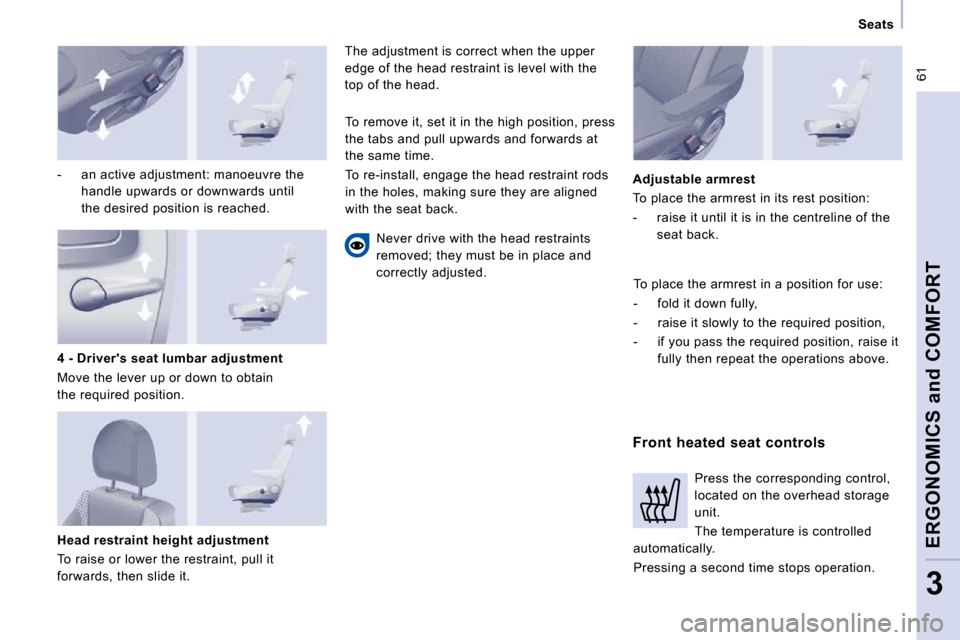
61
Seats
ERGONOMICS and COMFORT
3
- an active adjustment: manoeuvre the handle upwards or downwards until
the desired position is reached.
Head restraint height adjustment
To raise or lower the restraint, pull it
forwards, then slide it. The adjustment is correct when the upper
edge of the head restraint is level with the
top of the head.
Never drive with the head restraints
removed; they must be in place and
correctly adjusted.
Front heated seat controls
Adjustable armrest
To place the armrest in its rest position:
- raise it until it is in the centreline of the
seat back.
4 - Driver's seat lumbar adjustment
Move the lever up or down to obtain
the required position. To remove it, set it in the high position, press
the tabs and pull upwards and forwards at
the same time.
To re-install, engage the head restraint rods
in the holes, making sure they are aligned
with the seat back.
To place the armrest in a position for use:
- fold it down fully,
- raise it slowly to the required position,
- if you pass the required position, raise it fully then repeat the operations above.
Press the corresponding control,
located on the overhead storage
unit.
The temperature is controlled
automatically.
Pressing a second time stops operation.
Page 54 of 231
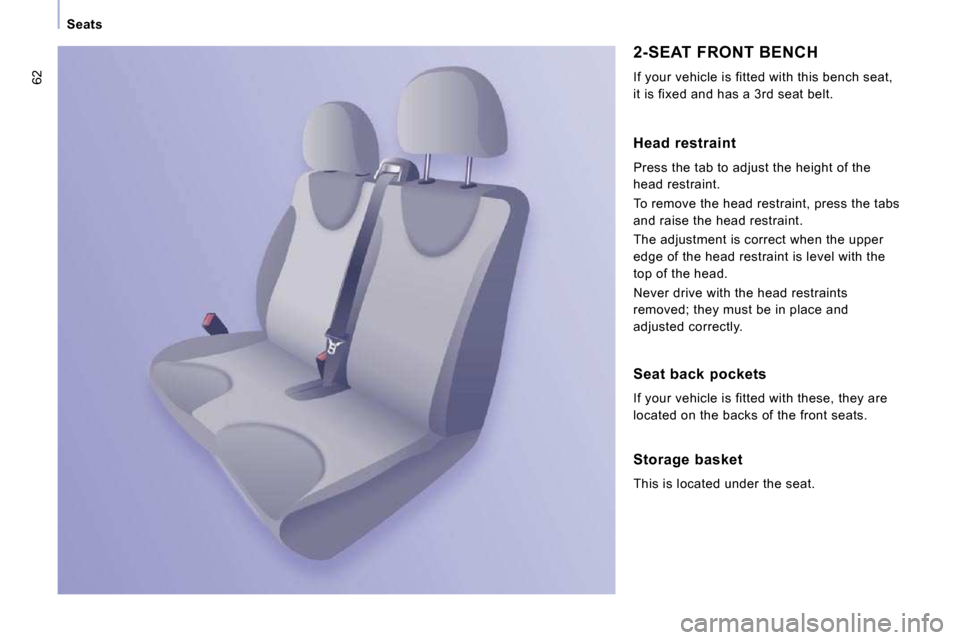
62
Seats
2-SEAT FRONT BENCH
If your vehicle is fitted with this bench seat,
it is fixed and has a 3rd seat belt.
Head restraint
Press the tab to adjust the height of the
head restraint.
To remove the head restraint, press the tabs
and raise the head restraint.
The adjustment is correct when the upper
edge of the head restraint is level with the
top of the head.
Never drive with the head restraints
removed; they must be in place and
adjusted correctly.
Storage basket
This is located under the seat.
Seat back pockets
If your vehicle is fitted with these, they are
located on the backs of the front seats.
Page 72 of 231
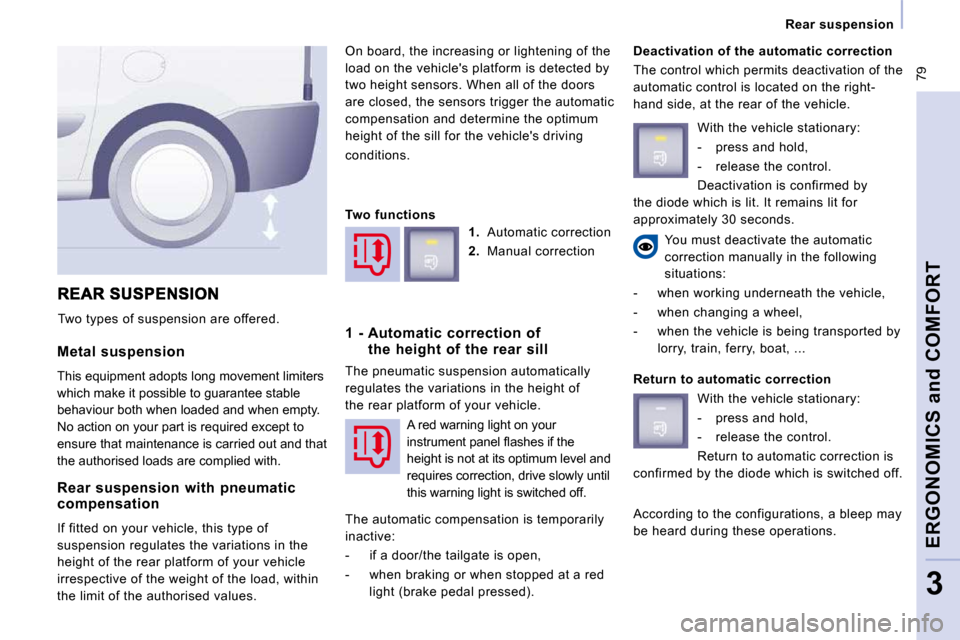
79
Rear suspension
ERGONOMICS and COMFORT
3
Metal suspension
This equipment adopts long movement limiters
which make it possible to guarantee stable
behaviour both when loaded and when empty.
No action on your part is required except to
ensure that maintenance is carried out and that
the authorised loads are complied with. On board, the increasing or lightening of the
load on the vehicle's platform is detected by
two height sensors. When all of the doors
are closed, the sensors trigger the automatic
compensation and determine the optimum
height of the sill for the vehicle's driving
conditions.
Deactivation of the automatic correction
The control which permits deactivation of the
automatic control is located on the right-
hand side, at the rear of the vehicle.
Two types of suspension are offered.
You must deactivate the automatic
correction manually in the following
situations:
- when working underneath the vehicle,
- when changing a wheel,
- when the vehicle is being transported by lorry, train, ferry, boat, ...
Rear suspension with pneumatic compensation
If fitted on your vehicle, this type of
suspension regulates the variations in the
height of the rear platform of your vehicle
irrespective of the weight of the load, within
the limit of the authorised values. Two functions
1. Automatic correction
2. Manual correction
1 - Automatic correction ofthe height of the rear sill
The pneumatic suspension automatically
regulates the variations in the height of
the rear platform of your vehicle.
The automatic compensation is temporarily
inactive:
- if a door/the tailgate is open,
- when braking or when stopped at a red
light (brake pedal pressed). With the vehicle stationary:
- press and hold,
- release the control.
Deactivation is confirmed by
the diode which is lit. It remains lit for
approximately 30 seconds.
Return to automatic correction
With the vehicle stationary:
- press and hold,
- release the control.
Return to automatic correction is
confirmed by the diode which is switched off.
According to the configurations, a bleep may
be heard during these operations.
A red warning light on your
�i�n�s�t�r�u�m�e�n�t� �p�a�n�e�l� �fl� �a�s�h�e�s� �i�f� �t�h�e�
height is not at its optimum level and
requires correction, drive slowly until
this warning light is switched off.
Page 73 of 231
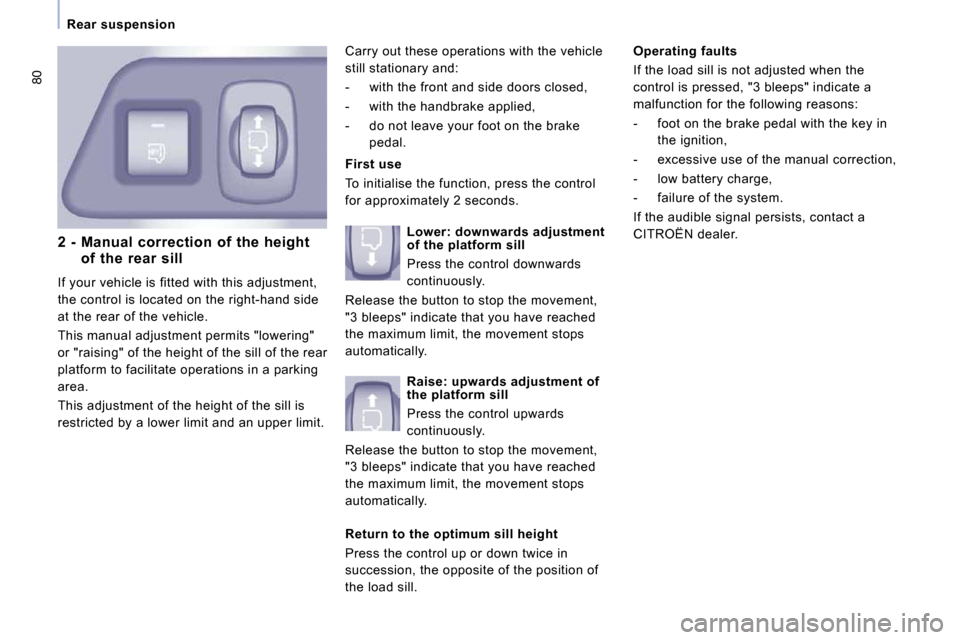
80
Rear suspension
2 - Manual correction of the height of the rear sill
If your vehicle is fitted with this adjustment,
the control is located on the right-hand side
at the rear of the vehicle.
This manual adjustment permits "lowering"
or "raising" of the height of the sill of the rear
platform to facilitate operations in a parking
area.
This adjustment of the height of the sill is
restricted by a lower limit and an upper limit. First use
To initialise the function, press the control
for approximately 2 seconds.
Operating faults
If the load sill is not adjusted when the
control is pressed, "3 bleeps" indicate a
malfunction for the following reasons:
- foot on the brake pedal with the key in
the ignition,
- excessive use of the manual correction,
- low battery charge,
- failure of the system.
If the audible signal persists, contact a
CITROËN dealer.
Carry out these operations with the vehicle
still stationary and:
- with the front and side doors closed,
- with the handbrake applied,
- do not leave your foot on the brake
pedal.
Lower: downwards adjustment
of the platform sill
Press the control downwards
continuously.
Release the button to stop the movement,
"3 bleeps" indicate that you have reached
the maximum limit, the movement stops
automatically.
Raise: upwards adjustment of
the platform sill
Press the control upwards
continuously.
Release the button to stop the movement,
"3 bleeps" indicate that you have reached
the maximum limit, the movement stops
automatically.
Return to the optimum sill height
Press the control up or down twice in
succession, the opposite of the position of
the load sill.
Page 74 of 231

81
Rear suspension
ERGONOMICS and COMFORT
3
Deactivation of the manual correction Good practice
When stationary and with the ignition key
removed, excessive use of the system
consumes battery charge. Parking for a long duration
Avoid parking for a long duration on ground
which could present a potential obstacle as
your vehicle could lower.
Following a long period out of use,
the height of the platform may change due to
the automatic compensation on unlocking or
on opening one of your vehicle's doors.
With the vehicle stationary:
- press and hold,
- release the control.
Deactivation is confirmed by
the diode which is lit. It remains lit for
approximately 30 seconds.
Return to manual correction
You must deactivate the manual
correction in the following situations:
- when working underneath the vehicle,
- when changing a wheel,
- when the vehicle is being transported by lorry, train, ferry, boat, ... Driving with the height of the rear platform:
- too low, risks damaging the technical
components underneath the vehicle,
- too high, risks unstable driving.
If you start and the warning light flashes, to
switch it off:
- correct the position of the manual control which is still at the lower or
upper limit,
- or drive slowly at above 6 mph (10 km/h), until the compensation
returns to automatic mode. Warning light
Refer to the "Instruments and controls"
section of chapter 2.
With the vehicle stationary:
- press and hold,
- release the control.
Return to manual correction is
confirmed by the diode which is switched off.
According to the configurations, a bleep may
be heard during these operations.
Page 82 of 231
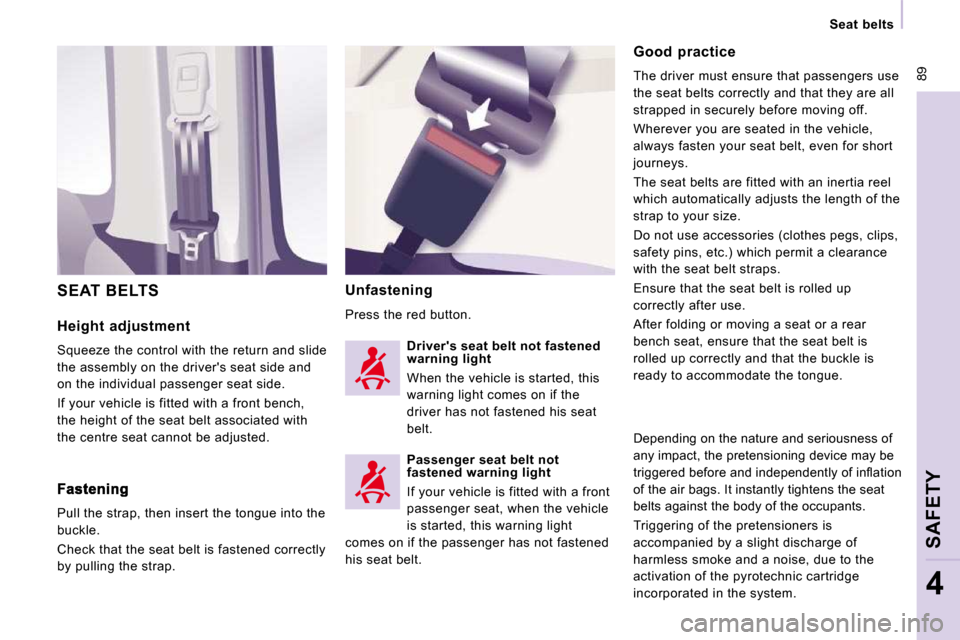
89
Seat belts
SAFETY
4
Height adjustment
Squeeze the control with the return and slide
the assembly on the driver's seat side and
on the individual passenger seat side.
If your vehicle is fitted with a front bench,
the height of the seat belt associated with
the centre seat cannot be adjusted.
Unfastening
Press the red button.
SEAT BELTS
Good practice
The driver must ensure that passengers use
the seat belts correctly and that they are all
strapped in securely before moving off.
Wherever you are seated in the vehicle,
always fasten your seat belt, even for short
journeys.
The seat belts are fitted with an inertia reel
which automatically adjusts the length of the
strap to your size.
Do not use accessories (clothes pegs, clips,
safety pins, etc.) which permit a clearance
with the seat belt straps.
Ensure that the seat belt is rolled up
correctly after use.
After folding or moving a seat or a rear
bench seat, ensure that the seat belt is
rolled up correctly and that the buckle is
ready to accommodate the tongue.
Pull the strap, then insert the tongue into the
buckle.
Check that the seat belt is fastened correctly
by pulling the strap. Driver's seat belt not fastened
warning light
When the vehicle is started, this
warning light comes on if the
driver has not fastened his seat
belt.
Passenger seat belt not
fastened warning light
If your vehicle is fitted with a front
passenger seat, when the vehicle
is started, this warning light
comes on if the passenger has not fastened
his seat belt. Depending on the nature and seriousness of
any impact, the pretensioning device may be
�t�r�i�g�g�e�r�e�d� �b�e�f�o�r�e� �a�n�d� �i�n�d�e�p�e�n�d�e�n�t�l�y� �o�f� �i�n�fl� �a�t�i�o�n�
of the air bags. It instantly tightens the seat
belts against the body of the occupants.
Triggering of the pretensioners is
accompanied by a slight discharge of
harmless smoke and a noise, due to the
activation of the pyrotechnic cartridge
incorporated in the system.
Page 101 of 231

Opening the bonnet
OPENING THE BONNET
From inside:
- lift the cover located at the left foot of the passenger ’s seat.
- pull the control upwards. To close
Lower the bonnet and release it at the end of its
travel. Check that the bonnet is properly locked.
From outside: partially open the bonnet, lift
the catch and raise the bonnet.
Bonnet strut
Secure the strut in one of the two notches,
according to the height required, to hold the
bonnet open.
Before closing the bonnet, replace the strut
in its housing. "Bonnet open" warning
This warning is linked to the
alarm option
only.
With the engine running or the
vehicle moving, a warning light
and a diagram on the display,
accompanied by an audible
signal, warn you that the bonnet
is not properly closed.